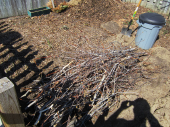
 20
20




 7
7




Regards, Scott
 5
5




"The rule of no realm is mine. But all worthy things that are in peril as the world now stands, these are my care. And for my part, I shall not wholly fail in my task if anything that passes through this night can still grow fairer or bear fruit and flower again in days to come. For I too am a steward. Did you not know?" Gandolf
 3
3




 3
3




Silence is Golden
For all your RMH needs:
dragontechrmh.com
 7
7




 1
1




Silence is Golden
For all your RMH needs:
dragontechrmh.com




 1
1




 1
1




Argue for your limitations and they are yours forever.
 1
1




Silence is Golden
For all your RMH needs:
dragontechrmh.com
 5
5








 5
5




Silence is Golden
For all your RMH needs:
dragontechrmh.com
 2
2




Gerry Parent wrote:Here is my progress on making a raised bed garden thanks to your inspiration.
“Uncertainty is an uncomfortable position. But certainty is an absurd one.”
― Voltaire
 1
1




 5
5




Silence is Golden
For all your RMH needs:
dragontechrmh.com
 2
2





Gerry Parent wrote:Being my first time at this, there was a learning curve. Choice of fabric was one of them. I had a whole pile of old towels, bed sheets, old curtains etc saved up for rags and drop cloths and not sure which ones to use I experimented with them all. I had read that dipping the cloth first in water to hydrate them before coating with a cement slurry was to help the fabric absorb the cement better. That made total sense and worked just fine with all the fabrics. Where it differed though was during the cement slurry application. The thicker cloths held a lot more cement and became much heavier and harder to handle bigger pieces and vise versa for the thinner fabrics. So obviously, you can get much more coverage using the thin ones and it was also a lot easier to wring out the excess slurry before draping them over the form work.
It seemed like a sure winner to use the thin fabric from now on....that is, until I inspected my work I did yesterday this morning.
The thin bed sheets had barely gotten stiff while the thicker ones had actually hardened up and held their shape well. So it looks like I'm going to have to go back over the thin areas with thicker fabrics. No big deal, just good to know.
Another thing I learned is that when I built the form work, it all had nearly vertical sides - some actually curved inwards and this meant that when I draped the cement soaked cloth over it, some of the sides didn't even touch the chicken wire and just dangled with no support behind them, making it almost impossible to plaster. Similar to what I think you found out Daniel.
It would have been better to taper the form work so that it was wider at the bottom and narrower at the top.
Will continue my experiments and report what works/ doesn't work for me.
London, UK based. Eco renovation of our tiny Victorian-terraced house using Passivhaus principles.
Follow us at https://www.instagram.com/little_london_terrace_eco_reno/
 2
2




Silence is Golden
For all your RMH needs:
dragontechrmh.com
 5
5




London, UK based. Eco renovation of our tiny Victorian-terraced house using Passivhaus principles.
Follow us at https://www.instagram.com/little_london_terrace_eco_reno/
 3
3




Silence is Golden
For all your RMH needs:
dragontechrmh.com





London, UK based. Eco renovation of our tiny Victorian-terraced house using Passivhaus principles.
Follow us at https://www.instagram.com/little_london_terrace_eco_reno/
 1
1




Silence is Golden
For all your RMH needs:
dragontechrmh.com













|
Morning came much too soon and it brought along a friend named Margarita Hangover, and a tiny ad.
Learn Permaculture through a little hard work
https://wheaton-labs.com/bootcamp
|




